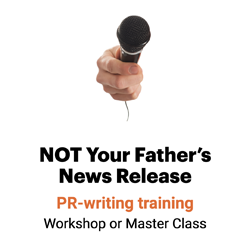Want readers to read? Lead with you
It’s counterintuitive, but true: The product is never the topic. The program is never the topic. The plan is never the topic. The topic is never the topic.

The reader is always the topic.
So put the reader first: Next time you find yourself writing a press release, write to and about your target audience, not about us and our stuff.
Here’s how to do it, stealing an approach from the lead of a PRSA Silver Anvil Award-winning release by the California Milk Advisory Board:
Dairy farmers throughout California — the nation’s No. 1 milk-producing state — will have an opportunity to learn the basics of cheese making in a comprehensive, one-day seminar being offered during February and March throughout the state. Sponsored by the California Milk Advisory Board …
Note that this release:
- Starts with the reader. “Dairy farmers throughout California …” See what happens when you begin your lead with the stakeholder, instead of with your organization’s or product’s name? You push the benefits toward the front of the lead.
-
Follows up with the benefit. “… will have an opportunity to learn the basics of cheese making …” We still haven’t mentioned the organization or offering. Why? Because the reader benefit is more important.
Notice how putting the reader first forces you from passive voice into active voice.
- Only then introduces the product or service. “… a comprehensive, one-day seminar …” The product or service is best placed, as in this release, after the end-user and benefit. In fact, the second paragraph is high enough for the product name.
-
Ends with the organization’s name. “Sponsored by the California Milk Advisory Board …” Trust me, if someone cares about your release, they’ll get to your organization’s name.
And journalists, bloggers and others are more likely to read or run the release when you focus on their audience members instead of on your organization and its stuff.
Notice how much more newsworthy and interesting this approach is than the traditional product announcement release, which is dated, formulaic and — let’s face it — dull.
Now you do it:
|
________________________________________ (Stakeholder) will soon be able to ________________________________________ (benefit) thanks to ________________________________________ (product or service) by ________________________________________ (organization). |
You’ll wind up with something like this:
The 2,000 commuters who now spend an hour each day driving from Sunrise Beach to Osage Beach will soon be able to make the trip in 15 minutes.
The reason: a new, $24 million bridge that Community Transport Corp. will build this summer.
Here are three other ways PR pros made the reader the topic in their PRSA Silver Anvil Award-winning campaigns.
1. Write to and about you.
The easiest way to write about the reader, in PR as well as in other pieces, is to use the magic word: You. That’s what PR pros did for these award-winning leads:
It’s on you. You have the power to save a life. That’s the message going out to [City] residents — especially those in the African American community — who will be asked to become potential marrow donors at a donor registry drive hosted by Be The Match®.
The [date] event is part of a nationwide effort during African American Bone Marrow Awareness Month.
— Be The Match media advisory
The billion dollar-a-year tax increase, Amendment 66, is like the latest “As Seen on TV” product. It’s full of promised innovation and life-changing outcomes, but post-purchase you realize you just spent a lot of money and nothing is actually better.
— Vote No on 66 campaign op-ed
Your school is invited to join Celebrate My Drive (CMD) 2013, an opportunity for students and communities to come together to celebrate [this year’s] class of new drivers. The first year behind the wheel is the most dangerous for teens, and it’s an issue we know is important to your school.
— State Farm Celebrate My Ride news release
2. Use the imperative voice.
Here’s another approach to leading with the reader: Use the imperative voice.
We learned in third grade to call the imperative voice the command voice. And it can be a command: Do the dishes. Make your bed. Clean your room.
When we use it, though, it’s the invitation voice: Grab a spade … prepare your senses … dig a little … learn a lot.
As spring temperatures go up, it’s an excellent time for farmers, ranchers and gardeners to focus their attention down to the soil below them. A spring check-up of your soil’s health gives clues of your ground’s ability to feed plants, hold water, capture carbon and more.
No fancy equipment required. Just grab a spade or shovel and prepare your senses to dig a little and learn a lot.
— Natural Resources Conservation Service news release
Working late again? You’re not alone, according to a new study by University of Arizona germ guru Dr. Charles Gerba. You have plenty of bacteria keeping you company.
The study, the first of its kind to measure normal bacterial levels inside offices across America, found paper isn’t all that’s piling up on desks. In fact, the average desk harbors 400 times more bacteria than the average toilet seat.
— Clorox Silver Anvil Award-winning release
3. Use a placeholder for ‘you.’
I actually prefer to avoid you and the imperative voice in media relations pieces. For one thing, who’s you — the reporter or the end reader? For another, I still like to retain an objective, third-person voice in PR pieces.
The solution? A placeholder for you: Community members. New drivers. Farmers throughout the state. Teens who commit to safe driving.
That’s how these Silver Anvil award-winners set up their stories:
Community members of all ages are invited to join Celebrity Chefs Nicolas Come of Nicolas’ Garden and Adam Pechal of “Restaurant THIR13EN” and “Tuli Bistro” fame, as they co-host the inaugural “Farm-to-Fork Family Food Feud,” game on Saturday, September 28, 2013, at 11:00 am.
— Nicolas’ Garden news release
Parents of teen drivers believe teens are obeying the letter of the law when it comes to graduated driving licensing (GDL) laws. As it turns out, what parents think — or hope — and what teens report actually doing don’t match up according to a new survey conducted by State Farm.
— State Farm news release
During National Teen Driver Safety Week, new drivers across North America are rallying their communities to commit to safe driving. Car crashes are the number one killer of teens in the US and Canada. Students in more than 3,000 participating high schools are celebrating the joy of driving while at the same time working to reverse this startling statistic.
— State Farm news release
A growing number of farmers throughout STATE have “discovered the cover” — and for some very good reasons. They’re increasingly recognizing that by using cover crops and diverse rotations, if s possible to actually improve the health and function of their soil.
— Natural Resources Conservation Service op-ed
Teens who commit to safe driving could have the chance to bring Grammy Award winner Kelly Clarkson to their hometown for a free concert this coming school year. As part of the company’s Celebrate My Drive® program, State Farm is teaming up with Clarkson and offering teens across the U.S. and Canada the opportunity to learn more about safe driving, win grant money for their school, and be one of two schools to win a free concert by Kelly.
— State Farm news release
Get ready, racing aficionados, zombie slayers, sports fans, warriors and entertainment lovers. The Xbox team is planning one of the biggest entertainment premieres of the year to celebrate the launch of Xbox One with Xbox fans around the world, when it launches next Friday, Nov. 22.
— Xbox Silver Anvil-winning promotion
Stop wasting their time.
Next time you’re ready to send a press release, it will probably look at first glance like a news story:
The California Milk Advisory Board announces a comprehensive, one-day seminar on cheese production.
But if you want to write an effective press release … if you want to engage editors or reporters — and their readers — in your story, take a tip from these Silver Anvil winners: Once you’ve written a press release, make sure you’ve put the most important information — how readers can use your product or service — up top.
It’s more important than the contact information. More important than press release distribution. Way more important than including a quote. Even more important than the press release headline.
So focus on the reader and the reader’s needs, not on us and our stuff.

Leave a Reply